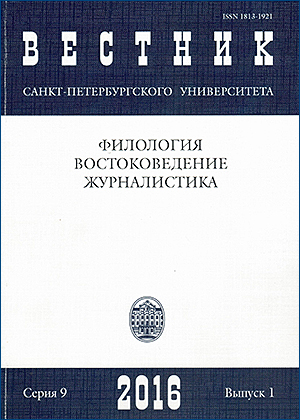Operating Norms Governing Translation on the Basis of Russian-Chinese Corpora — with a Case of чтобы Clauses in Russian [О нормах перевода сложных предложений с союзом чтобы (на материале корпуса русского и китайских языков)]
DOI:
https://doi.org/10.21638/11701/spbu09.2016.111Аннотация
В статье на основе корпуса русского и китайского языков исследуются нормы перевода сложных предложений с союзом чтобы. Делаются следующие выводы. Существует три вида переводческой нормы: нормы экспликации-импликации, нормы упрощения-усложнения и нормы одомашнивания-иностранизации. Соотношение экспликации и импликации при переводе предложений с союзом чтобы рассматривается в связи с тем, что различия между русским и китайским языками в это области более значительны, чем между английским и китайским. В переводных текстах больше простых предложений, чем в исходных, но в то же вре мя больше сложных предложений, чем в непереводных, поскольку в русском языке сложные предложения используются чаще, чем в китайском. В связи со структурными особенностями русского языка при переводе предложений с чтобы более очевидно применение принципа иностранизации, а не одомашнивания.
Скачивания
Библиографические ссылки
Библиография:
Baker M. Corpus Linguistics and Translation Studies: Implications and Applications. Text and Technology: in Honor of John Sinclair. Eds M.Baker, G.Francis, E.Tognini-Bonellis. Amsterdam, John Benjamins Publ., 1993.
Baker M. Routledge Encyclopedia of Translation Studies. London, New Yorker, Routledge, 2001. Chesterman A. Memes of Translation. The Spread of Ideas in Translation Theory. Amsterdam, Philadelphia, Benjamins, 1997.
Hermans T. Translation in Systems: Descriptive and System-oriented Approaches Explained. Manchester, St. Jerome Publishing, 1999.
Hu Kai-bao. Syntactic Operational Norms of Press Conference Interpreting (Chinese-English). Foreign Language Teaching and Research, 2012, vol. 5, pp. 738–750.
Hu Xiao-yao. A Corpus-based Study on the Translational Norms of Contemporary Chinese Fiction. Shanghai, East China Normal University, 2006.
Hu Xiao-yao. Corpus-based Translation Study on Modern Chinese. Beijing, Foreign Language Press, 2008.
Huang Li-bo, Zhu Zhi-yu. Corpus-based Translatology: Research Focus and Methodology. Foreign Languages in China, 2012, vol. 6, pp. 28–35.
Huang Li-bo. A Corpus-based Research on Translation Universals in Chinese-English. English-Chinese Translation. Shanghai, Fudan University Press, 2007.
Palumbo G. Key Terms in Translation Studies. London, Continuum International Publishing Group, 2009.
Qin Hong-wu. Load Capacity of Constructions in Translational Chinese: A Multi-version Corpus-based Study. Journal of Foreign Languages, 2010, vol. 4, pp. 73–80.
Tang Fang, Li De-chao. Explicitation in Chinese-English Consecutive Interpretation-A Comparative Study of Professional and Student Interpreter. Foreign Language Teaching and Research, 2013, vol. 3б pp. 442– 453.
Tao Yuan. On Some Transitional Features of Classification of Russian Complex Sentences. Shandong Foreign Language Teaching Journal, 2006, vol. 1, pp. 43–46.
Tao Yuan, Zakharov V. P. The Development and Use of Russian-Chinese Parallel Corpus. Automatic Documentation and Mathematical Linguistics, 2015, vol. 2, pp. 65–75 (in press).
Toury G. In Search of a Theory of Translation. Tel Aviv, The Porter Institute for Poetics and Semiotics, Tel Aviv University, 1980.
Toury G. Descriptive Translation Studies and Beyond. Amsterdam, John Benjamins Publ., 1995.
Wang Ke-fei. A Probe into Corpus-based Translatology. Shanghai, Shanghai Jiaotong University Press, 2012.
Wang Yong-na. Analyses of the Differences Between “Weile” and “Yibian” & SL Acquisition Situation in Overseas Students (Unpublished MA thesis). Guangzhou, Ji Nan University, 2004.
Zhang Hui-sen. A Comprative Study on Russian-Chinese Study. Shanghai, Shanghai Foreign Language Education Press, 2004.
Zhao Shi-ju. Lexical Decisive Function of Meaning on Grammar. Wuhan University Journal (Humanity Sciences), 2008, vol. 2, pp. 173–179.
Kozhina M. N. Stilistika russkogo iazyka [Stylistics of the Russian language]. Moscow, Prosveshchenie Publ., 1983. (In Russian)
Bibliography:
Baker, M. Corpus Linguistics and Translation Studies: Implications and Applications. Text and Technology: in Honor of John Sinclair. Eds M.Baker, G.Francis, E.Tognini-Bonellis. Amsterdam, John Benjamins Publ., 1993.
Baker, M. Routledge Encyclopedia of Translation Studies. London, New Yorker, Routledge, 2001.
Chesterman, A. Memes of Translation. The Spread of Ideas in Translation Theory. Amsterdam, Philadelphia, Benjamins, 1997.
Hermans, T. Translation in Systems: Descriptive and System-oriented Approaches Explained. Manchester, St. Jerome Publishing, 1999.
Hu, Kai-bao. Syntactic Operational Norms of Press Conference Interpreting (Chinese-English). Foreign Language Teaching and Research, 2012, vol. 5, pp. 738–750.
Hu, Xiao-yao. A Corpus-based Study on the Translational Norms of Contemporary Chinese Fiction. Shanghai, East China Normal Univ., 2006.
Hu, Xiao-yao. Corpus-based Translation Study on Modern Chinese. Beijing, Foreign Language Press, 2008.
Huang, Li-bo, Zhu, Zhi-yu. Corpus-based Translatology: Research Focus and Methodology. Foreign Languages in China, 2012, vol. 6, pp. 28–35.
Huang, Li-bo. A Corpus-based Research on Translation Universals in Chinese-English. English-Chinese Translation. Shanghai, Fudan Univ. Press, 2007.
Palumbo, G. Key Terms in Translation Studies. London, Continuum International Publishing Group, 2009.
Qin, Hong-wu. Load Capacity of Constructions in Translational Chinese: A Multi-version Corpus-based Study. Journal of Foreign Languages, 2010, vol. 4, pp. 73–80.
Tang Fang, Li, De-chao. Explicitation in Chinese-English Consecutive Interpretation-A Comparative Study of Professional and Student Interpreter. Foreign Language Teaching and Research, 2013, vol. 3б pp. 442– 453.
Tao, Yuan. On Some Transitional Features of Classification of Russian Complex Sentences. Shandong Foreign Language Teaching Journal, 2006, vol. 1, pp. 43–46.
Tao, Yuan, Zakharov, V. P. The Development and Use of Russian-Chinese Parallel Corpus. Automatic Documentation and Mathematical Linguistics, 2015, vol. 2, pp. 65–75 (in progress).
Toury, G. In Search of a Theory of Translation. Tel Aviv, The Porter Institute for Poetics and Semiotics, Tel Aviv Univ., 1980.
Toury, G. Descriptive Translation Studies and Beyond. Amsterdam, John Benjamins Publ., 1995.
Wang, Ke-fei. A Probe into Corpus-based Translatology. Shanghai, Shanghai Jiaotong Univ. Press, 2012.
Wang, Yong-na. Analyses of the Differences Between “Weile” and “Yibian” & SL Acquisition Situation in Overseas Students (Unpublished MA thesis). Guangzhou, Ji Nan Univ., 2004.
Zhang, Hui-sen. A Comprative Study on Russian-Chinese Study. Shanghai, Shanghai Foreign Language Education Press, 2004. (in Russian)
Zhao, Shi-ju. Lexical Decisive Function of Meaning on Grammar. Wuhan University Journal (Humanity Sciences), 2008, vol. 2, pp. 173–179.
Kozhina, M. N. Stilistika russkogo iazyka [Stylistics of the Russian language]. Moscow, Prosveshchenie Publ., 1983. (In Russian)
Загрузки
Опубликован
Как цитировать
Выпуск
Раздел
Лицензия
Статьи журнала «Вестник Санкт-Петербургского университета. Язык и литература» находятся в открытом доступе и распространяются в соответствии с условиями Лицензионного Договора с Санкт-Петербургским государственным университетом, который бесплатно предоставляет авторам неограниченное распространение и самостоятельное архивирование.






